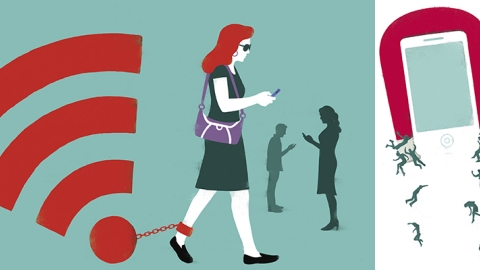
Instant Gratification & Its Dark Side
July 17, 2014
By Ronald Alsop • Illustration by Sébastien Thibault
Heather Hennigan ’15 can’t resist checking her smartphone when it buzzes or rings. Sometimes she even imagines feeling a vibration in her pocket when the phone is actually tucked away in her bag.
“It’s crack. It’s an addiction,” Hennigan says. “I feel that maybe I’m going to miss out on something if I wait to check my text messages and emails. It could be a friend I really want to see texting me to go have lunch, or a professor sending an email to change a homework assignment.”
Hennigan’s desire to stay connected to her phone reflects the world’s growing need for instant gratification, especially through online connections. That’s how social media sites have hooked millions of people; they provide instant gratification whenever their members need it. On Facebook, for example, likes, shares and comments make users feel good, and those users come to expect such immediate response and satisfaction whenever they post a comment or picture.
The millennial generation — born during the 1980s and 1990s — grew up on technology and feels the pull of instant gratification more intensely than older generations. About 60 percent of 18-to-34-year-old respondents to a Pew Research Center survey said they sleep next to their cell phones so they don’t miss calls, texts or updates during the night. And much like Hennigan with her phantom vibrations, more than three-quarters of that age group check their phones for messages or missed calls — even when they didn’t notice their phones ringing.
Millennials tend to expect immediate responses to emails and texts and find it unbearable to lose access to the internet’s rich trove of information. “The internet wasn’t working one day on campus, and I got so frustrated I didn’t know what to do,” says Tooba Ali ’17, who will start her second year at Bucknell this fall. “I get angry if I can’t get what I want right away. On tests, for example, I want to know right away the grade I got and figure out what I did wrong by immediately going on the internet.”
Millennials find it more difficult than previous generations to delay not just the gratification of a good grade or a Facebook conversation, but also some of the more important aspects of their lives. Most notably, many young professionals today want their careers to be on steroids. They crave the gratification of a pay raise or promotion every few months, and when they don’t get the expected rewards, they feel frustrated and sometimes even quit their jobs. Such behavior is creating retention headaches for some employers and could make impatient, job-hopping millennials unappealing to companies.
The need for instant gratification is likely to become even more pronounced in the generation born after 2000. More than 70 percent of children age 8 and under had used a mobile device for some type of media activity (such as playing games, using apps or watching videos) in 2013, up from 38 percent in 2011, according to a survey of parents by Common Sense Media, a nonprofit that provides information and recommendations about young people’s media use. Even babies and toddlers are being given access to tablets and smartphones these days: Some 38 percent of children under 2 had used a mobile device for media activity, up from 10 percent two years earlier.
Patience was long considered a virtue, but it seems more like an anachronism today. DVRs have eliminated the need to waste time watching commercials, and viewers can get their entertainment fix immediately with on-demand movies. Why stand in line or make a phone call when smartphone apps let consumers book dinner reservations and buy movie tickets in seconds? And there’s no longer any need to wait to meet someone to date when apps, using location-based technology, can instantly connect people who happen to be hanging out in the same neighborhood.
The unmistakable message people receive in both the workplace and marketplace is that faster is better. Indeed, companies are counting on people’s impatience to sell their services. Internet service providers promise ever-faster connections — for a hefty price, of course. Verizon is aggressively promoting its Quantum FIOS service, which comes in several different speeds the company claims “will take your breath away.” Verizon’s “rocket fuel” speed — about $210 a month — promises to download a high-definition movie in 2.2 minutes or upload 200 photos in 31 seconds. Still too slow? There’s also “supersonic” speed — about $300 a month — that will finish the video download in 1.4 minutes and the photo upload in 20 seconds.
Similarly, a growing number of retailers are trying to tempt consumers with costly same-day delivery options. Amazon offers same-day delivery in some cities, which means packages ordered early in the day will arrive by 8 p.m. If that still seems like eons, then just wait a few years. Its R&D team is developing Prime Air unmanned aerial vehicles, commonly known as drones, to get packages in customers’ hands in 30 minutes or less.
“One day,” Amazon boasts on its website, “Prime Air vehicles will be as normal as seeing mail trucks on the road today.” Of course, that begs the question: Why wait even half an hour for a drone delivery when a customer can download an e-book, music album or movie in a few seconds or minutes with Verizon’s supersonic internet service?
The new Google Glass, a computer built into eyeglass frames, will take instant gratification to yet another level by allowing people to send messages, read news headlines, snap a picture or get directions — all hands free — as they’re moving about.
In the workplace, meanwhile, more companies are adopting BYOD (bring your own device) policies, giving people even greater opportunity to feed their technology addictions throughout the workday. At the same time, employers are requiring many of their workers to be on call 24/7, tying them even more tightly to their mobile devices. More than a third of U.S. workers say they must stay connected to their offices during vacations, with 89 percent of them checking email and 70 percent making work-related calls, according to a study by staffing agency Adecco.
The need for round-the-clock connection not only makes people more impatient, it also robs them of time for quiet reflection or deeper, more critical thinking. They tend to want constant stimulation, have less impulse control and get distracted more easily. Diagnoses of attention deficit disorder for children and teenagers have soared; even older adults are increasingly getting prescriptions for ADD medications. Some teachers report that they rarely assign complete books any longer, but choose short stories or excerpts instead because of shorter attention spans.
More than 70 percent of elementary, middle and high school teachers say media use has hurt students’ attention spans, while more than 40 percent believe it has interfered with students’ critical thinking and their ability to engage with subject matter, according to a 2012 study by Common Sense Media. The top offenders the teachers cited: video games (68 percent of respondents) and texting (66 percent).
Of course, waiting has long been considered an annoying waste of time, and technology has only intensified the feeling. What people don’t realize is that waiting does have its merits. “The promise of technology was that it would make us masters of time,” says Professor of English Harold Schweizer. “It has, ironically, made us into time’s slaves.”
He is a passionate advocate of the value of waiting and even wrote a book titled On Waiting. To Schweizer, waiting gives people time for thinking, inspiration and regeneration. It also adds value to objects and experiences. “I recall that it was John Crowe Ransom who some 50 years ago pointed out that in courtship the object of desire attains value precisely through the time a courtship takes,” Schweizer says. “Compare this to the contemporary culture of hooking up on our campuses.”
He also believes that reading or studying is essentially an act of courtship — of waiting — by which a poem, painting or difficult concept “attains value because we have waited for it, waited on it.” But without the investment of time, he says, “objects and experiences tend to remain without value.”
In his teaching, Schweizer often pauses to give students time to gain unexpected insights about a piece of literature. In his personal life, he slows down by hiking, bicycling and kayaking on the Susquehanna River. Ironically, he notes, our culture more highly prizes fast-paced recreational activities such as jogging, mountain biking and jet skiing, which “cannot give us reprieve from haste and greed.”
The need for instant gratification has resulted in an explosion of so-called multitasking in people’s daily lives. Many students and employees believe using multiple technologies at once to do work and to socialize makes them happier and more productive — even though research repeatedly has shown that splintering one’s focus tends to reduce rather than increase efficiency.
The compulsion to multitask also is contributing to a loss of civility in society. Movie and Broadway theaters now must ask audience members to refrain from texting during performances. And during business meetings or presentations, employees are sometimes told to put their phones on a table by the door because many can’t resist checking email or sending out texts or tweets, even if they risk offending others.
Researchers have found that people are definitely upset when work colleagues multitask during phone or face-to-
face conversations. It’s especially annoying during a phone conversation when the other person can be heard pecking on a keyboard and asks the caller to keep repeating comments. Young people generally say they don’t consider such behavior offensive, but Ann-Frances Cameron, an associate professor of information technology at the HEC Montreal business school, found in a study that people of all ages judged “multicommunication” to be rude. “If you’re going to multicommunicate, you should at least explain why,” she says. “You might say, for example, that you want to text a colleague to get updated information.”
The rule in Cameron’s classes: When students enter her room, she has their undivided attention. They must put away phones and for part of the class close computers. If they say they have received an urgent message, they can ask permission to leave the classroom. “It’s a case of curiosity killed the cat,” Cameron says. “They can’t hear a message come in without wanting to see what it’s about. They know it might be interesting or from someone they like to hear from. There’s definitely an addictive side to the behavior.”
Most people can keep their need for instant gratification from taking control of their lives. But some do become so addicted to technology that they need professional help. In the United States, there are only a few facilities designed specifically for internet addiction, but treatment centers are more common in some countries, such as South Korea.
Last year, Bradford Regional Medical Center in Bradford, Pa., opened what it says is America’s first hospital-based program for treating internet addiction. “We use specialized cognitive behavioral treatment and try to get people to look at internet addiction like food addiction,” says Kimberly Young, program director at Bradford and founder of the Center for Internet Addiction. “It’s a matter of moderating, going on a digital diet.”
After a 72-hour digital detox, technology devices such as laptops are reintroduced to patients during the treatment program, which lasts 10 days but can continue for 21 days if necessary. “Then, we teach them to be mindful of their use of technology,” Young says.
The treatment program attracts many young people, but a 53-year-old man also recently contacted Young about his online pornography addiction, which has affected his job and marriage. “Like drug or alcohol addiction, internet addiction can happen to anyone at any age,” she says.
Among college students, she says, the problem is worst at the most prestigious schools, where bright but socially introverted people may be addicted to video gaming. “I’ve talked to a number of college counseling centers to discuss raising awareness of internet addiction and getting a dialogue going,” she says. “But they’re more concerned about drugs and alcohol.”
Young also often works with parents, along with the addicted child, to coach them on managing technology at home. “I often deal with parents after their kid has failed out of college or lost a scholarship,” she says.
Brian Schurr, a staff psychologist at Psychological Services, says that while as many as 9 million people in the United States are at risk of developing some form of internet-related problem, internet addiction is not a pressing concern at Bucknell. But “it can be identified later through the therapy work,” he says. “It is possible since so many of our students have grown up in a technological age, they do not self-identify their use of the internet as problematic.”
The good news is that more people are recognizing the need to take a technology break. Resorts and retreats, ranging from Zen meditation centers and abbeys to luxury hotels in the Utah desert, are attracting guests who want to escape for a while from the online world. Some entrepreneurs also are developing technologies to help people unplug.
CanFocus, a startup in Toronto, has created software for the workplace that will simultaneously stop most electronic distractions by silencing cell phones and blocking incoming messages and emails on various devices. All the user has to do is press a large button on his desk that switches from green to red. A red button will also become visible to people outside the office or cubicle.
“You could do five or six separate muting operations, including hanging up a Do Not Disturb sign, but this basically does it all at once,” says Igal Roytblat, chief technology officer of CanFocus. “The red button also reminds you that you’re trying to focus and that there isn’t any email for you to check. We are often our own worst enemy when we’re trying to focus on something important.”
Bucknell encourages people to disconnect with its annual Dancing Mind Challenge, inviting students, faculty and staff to unplug for four or eight hours and spend that time reading without distraction. Participants aren’t even allowed to read on tablets.
“I think it’s a moment of self-discovery,” says Professor of English Carmen Gillespie, who started the Dancing Mind Challenge. “It gets students and others to think about incorporating some caution about their over-engagement with technology. Then, perhaps they’ll start to take a respite from technology on their own.”
Although students say it’s very difficult to disconnect, they find it refreshing. Heather Hennigan took the Dancing Mind Challenge last fall and recalls that she “felt like I had been in the Twilight Zone.” But she also found it “therapeutic” and for a few weeks turned off her phone for a couple of hours at a time. Soon, however, it became too inconvenient to be cut off from friends and professors. “I feel secure, locked into the world, when I have my phone,” she says.
Allison Shook ’14, who also participated in last fall’s Dancing Mind Challenge, experienced her biggest break from technology’s siren call when she studied abroad in Australia. “It was probably the best thing that could have happened to me,” she recalls. “I was living with Australians, and my regular phone didn’t connect with the people there. I also didn’t need to always check email to know everything that was happening back on campus. I used my laptop mostly just to do my homework.”
It seems that the later young people begin using smartphones and receive their own laptops, the easier it is to disconnect. For example, Cory Bishop ’12 grew up on the island of St. Croix and didn’t have his first iPhone until his senior year of high school. He spent much of his free time sailing, climbing trees and “getting lost in the acres of land around our house” instead of texting and surfing the web. Today, he still likes to experience life offline when possible. When he goes to the gym, for instance, he puts his phone on airplane mode so he can listen to music without the interruption of text and email beeps.
“The focus needs to be on moderation,” says Bishop, who works as a set designer for fashion videos and photography and recently developed a shopping app called ShopDrop. “If I don’t use airplane mode at times, I always feel that I have
to respond immediately to a text or email.”
He is relieved that his younger sister back on St. Croix goes swimming and sailing whenever she has the chance, much as he did. “But it pains me to see the horrible trend of other kids on their phones all day on St. Croix,” he says. If a Caribbean island can’t lure kids outside and away from phones, computers and video games, he adds, “we have a lot of work to do to balance our lives.”
Ronald Alsop is a freelance journalist and book author. A longtime reporter and editor for The Wall Street Journal, he is the author of eight books, including his latest, The Trophy Kids Grow Up: How the Millennial Generation Is Shaking Up the Workplace. His other books include The Wall Street Journal Guide to the Top Business Schools and The 18 Immutable Laws of Corporate Reputation: Creating, Protecting, and Repairing Your Most Valuable Asset.

